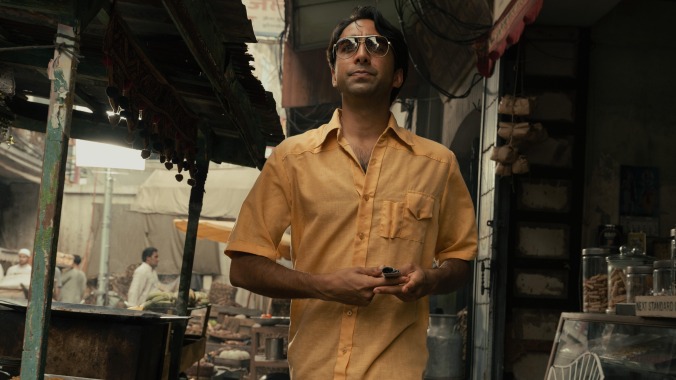Shantaram isn't just misguided, it's monotonous
The Apple TV Plus series is inconsistent and overly long, wasting strong efforts by stars Charlie Hunnam and Shubham Saraf

Apple TV+’s Shantaram, an adaptation of Gregory David Roberts’ sprawling, almost 1,000-page novel of the same name, certainly seemed promising enough. After all, the story combines the elements of a tense thriller, a mafia tale, an emotional drama, and even a romance. It’s too bad, then, that these components are so poorly mashed together, and that the show’s 12 excruciatingly slow hour-long episodes fail to offer much in the way of insight or nuance. And while Shantaram features stellar performances from leads Charlie Hunnam and Shubham Saraf, as well as exceptional camerawork by director Bharat Nalluri, they can’t overcome the series’ downright infantile writing.
The show follows Dale Conti (Hunnam), who adopts the name Lin Ford after escaping from an Australian prison and running off to Bombay, India (now called Mumbai), in 1982. In this fish-out-of-water story about a foreigner seeking a fresh start in another part of the world, Lin finds a best friend in his tour guide, Prabhu (Saraf), and a community in the slums where he lives.
Among the show’s many challenges is that it trembles under the “white savior complex” trope, even if tries not to. With Lin at the center of a story in a world he doesn’t naturally belong to, that’s almost impossible to avoid. As soon as he settles into the Sagar Wada shanties, living in a hut alongside Prabhu, the former paramedic begins to offer up medical services. This leads to scenes of slum-dwellers gratefully showering him with praise, gifts, and in some cases, actually falling at his feet. It’s an absurd sight to watch on screen in the year 2022.
Even worse is some of the dialogue. In one episode, Lin shows some semblance of self-awareness in his otherwise useless (and sadly, frequent) narration. “In my ignorance, I decided it was my job to fix the thing they didn’t see as broken,” he says about his new home. It’s a sign that Shantaram creators and writers are aware of the central problem—it’s the same criticism Roberts’ book received, especially from Indian readers. But that recognition doesn’t last long. Later in the same episode, Lin’s love interest, Swiss-American Karla (Antonia Desplat), visits him in the slum and with a flirtatious grin delivers the eye-rolling line: “Poverty looks good on you.”
At a time when South Asian projects and characters have finally expanded beyond stereotypes on television (Never Have I Ever, Ms. Marvel, Master Of None, Bridgerton, Amrit Kaur in The Sex Lives Of College Girls, Nikesh Patel in Starstruck), the cringe-worthy depictions in Shantaram are so unnecessary. Granted, the series is based on the book, but the show takes creative liberties and switches up plot twists elsewhere, so why stick to such a relatively shallow portrayal of India? It’s also in stark contrast to Apple TV+’s other adaptation from 2022, Pachinko, which beautifully explores three generations of an immigrant family, from a grandmother who lived through Japanese-occupied Korea to her American-educated grandson who returns to Japan.
The most authentic moments about the place, culture, and language in Shantaram stem from Prabhu and the people living around him. Saraf is a scene-stealer as his character is forced to grow up after Lin’s arrival. He evolves from an easygoing, money-minded dude to someone who’s capable of stepping up when his loved ones need him, especially his love interest, Parvati (Rachel Kamath). Saraf imbues Prabhu with a naturalness, easily using Bombay-specific phrases (“Yaar” for a friend, “boss” while addressing someone, etc.). He is the heart of Shantaram, and it’s hard not to wonder what a show from his perspective might look like. [As an aside, I highly recommend checking out the 2004 Shah Rukh Khan-starrer Swades, which tackles similar themes with proper nuance].
Once settled in Bombay, Lin patronizes a watering hole called Reynaldo’s Cafe (inspired by Mumbai’s real-life Leopold’s Cafe) and befriends tourists like Didier (Vincent Perez), the savvy businesswoman Karla, and her friend Lisa (Elektra Kilbey), a prostitute. Both women are involved in illegal activities, with warring factions of goons vying to take over the city. This leads to several meandering subplots that take ages to elevate into a meaningful arc.
Karla’s work for local leader Khader Khan (Alexander Siddig) takes prominence, but there’s no notion of what they want to accomplish, or why they’re loyal to each other. It’s difficult to care about anyone not named Lin or Prabhu, even as Shantaram bombards viewers with 20 other people, none of whom get sufficient development. There are Italian drug lords, a Spanish henchman, a German brothel owner, and a Black criminal, all conducting business, but we don’t get any real insight into why they’re in Bombay in the first place. Heck, we barely figure out why Lin chose to run to India.
Hunnam is charming and riveting, bringing depth and expressiveness to Lin, and Saraf is a treat. But they can’t overcome below-average performances from the rest of the ensemble, who often feature cartoonish accents. Siddig, a star in his own right, has nothing but bland dialogue here; the man deserves meatier material. Shantaram tightens the action in the last two episodes as disparate narratives converge, but that’s far too late to salvage a wearisome and misguided 12 hours.